Cadbury Marketing Essentials Report: Roles, Mix and Strategy
VerifiedAdded on 2020/11/12
|19
|5050
|295
Report
AI Summary
This report offers a comprehensive analysis of Cadbury's marketing strategies, covering various aspects such as pricing, product management, promotion, and distribution. It delves into the roles and responsibilities of the marketing function within Cadbury, examining its interrelationships with other organizational units like finance, human resources, and administration. The report utilizes the SOSTAC analysis framework to evaluate Cadbury's marketing environment, objectives, and strategies. Furthermore, it compares Cadbury's marketing mix, including the 7Ps (Product, Price, Place, Promotion, Process, Physical Evidence, and People), with that of its competitor, Nestle. The report also produces and evaluates a basic marketing plan, providing detailed evidence-based recommendations for Cadbury to achieve its business objectives and maintain a competitive edge in the market. The report concludes with a critical analysis of the key elements of the marketing function and their interplay with other organizational units.

MARKETING ESSENTIALS
Paraphrase This Document
Need a fresh take? Get an instant paraphrase of this document with our AI Paraphraser
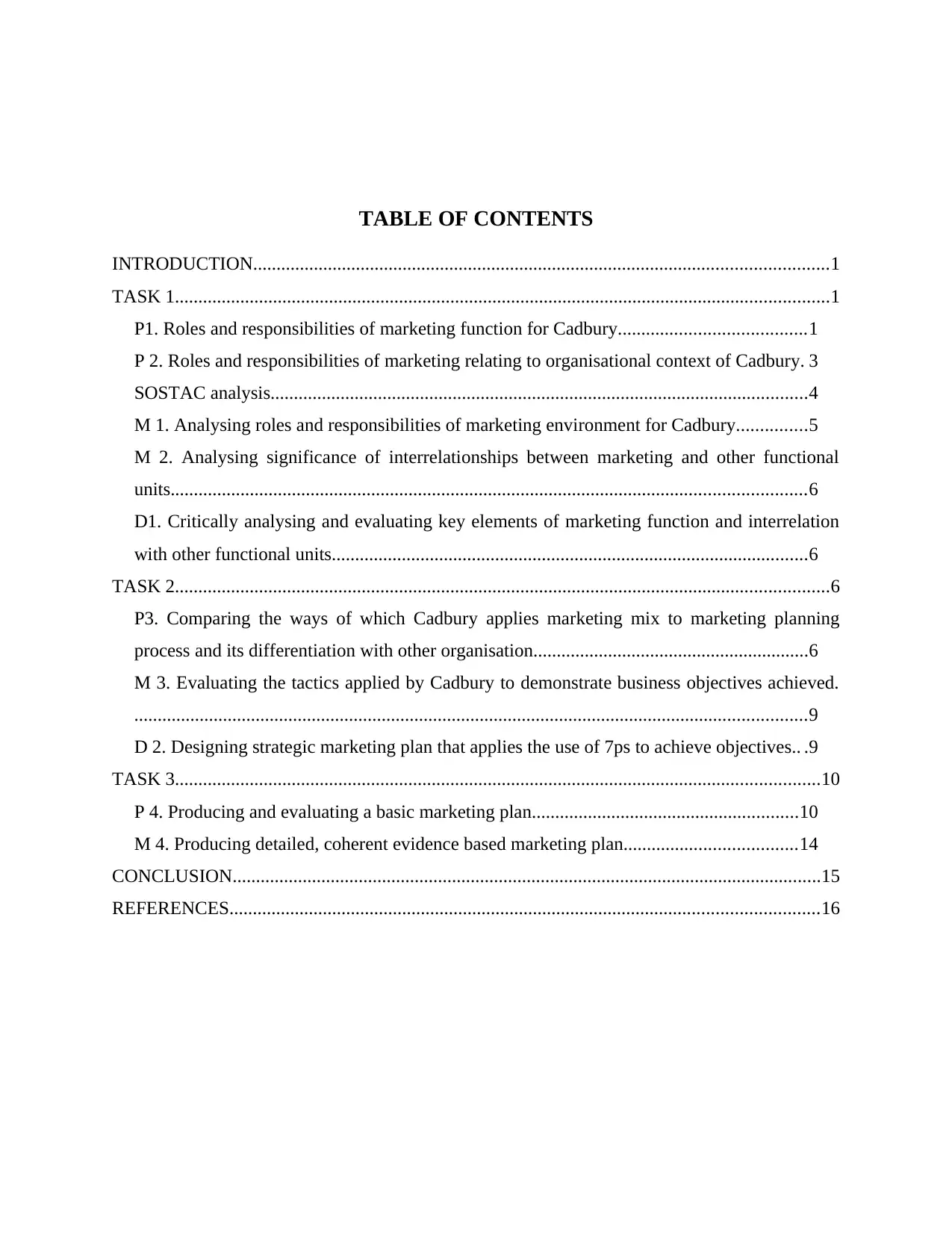
TABLE OF CONTENTS
INTRODUCTION...........................................................................................................................1
TASK 1............................................................................................................................................1
P1. Roles and responsibilities of marketing function for Cadbury........................................1
P 2. Roles and responsibilities of marketing relating to organisational context of Cadbury. 3
SOSTAC analysis...................................................................................................................4
M 1. Analysing roles and responsibilities of marketing environment for Cadbury...............5
M 2. Analysing significance of interrelationships between marketing and other functional
units........................................................................................................................................6
D1. Critically analysing and evaluating key elements of marketing function and interrelation
with other functional units......................................................................................................6
TASK 2............................................................................................................................................6
P3. Comparing the ways of which Cadbury applies marketing mix to marketing planning
process and its differentiation with other organisation...........................................................6
M 3. Evaluating the tactics applied by Cadbury to demonstrate business objectives achieved.
................................................................................................................................................9
D 2. Designing strategic marketing plan that applies the use of 7ps to achieve objectives.. .9
TASK 3..........................................................................................................................................10
P 4. Producing and evaluating a basic marketing plan.........................................................10
M 4. Producing detailed, coherent evidence based marketing plan.....................................14
CONCLUSION..............................................................................................................................15
REFERENCES..............................................................................................................................16
INTRODUCTION...........................................................................................................................1
TASK 1............................................................................................................................................1
P1. Roles and responsibilities of marketing function for Cadbury........................................1
P 2. Roles and responsibilities of marketing relating to organisational context of Cadbury. 3
SOSTAC analysis...................................................................................................................4
M 1. Analysing roles and responsibilities of marketing environment for Cadbury...............5
M 2. Analysing significance of interrelationships between marketing and other functional
units........................................................................................................................................6
D1. Critically analysing and evaluating key elements of marketing function and interrelation
with other functional units......................................................................................................6
TASK 2............................................................................................................................................6
P3. Comparing the ways of which Cadbury applies marketing mix to marketing planning
process and its differentiation with other organisation...........................................................6
M 3. Evaluating the tactics applied by Cadbury to demonstrate business objectives achieved.
................................................................................................................................................9
D 2. Designing strategic marketing plan that applies the use of 7ps to achieve objectives.. .9
TASK 3..........................................................................................................................................10
P 4. Producing and evaluating a basic marketing plan.........................................................10
M 4. Producing detailed, coherent evidence based marketing plan.....................................14
CONCLUSION..............................................................................................................................15
REFERENCES..............................................................................................................................16
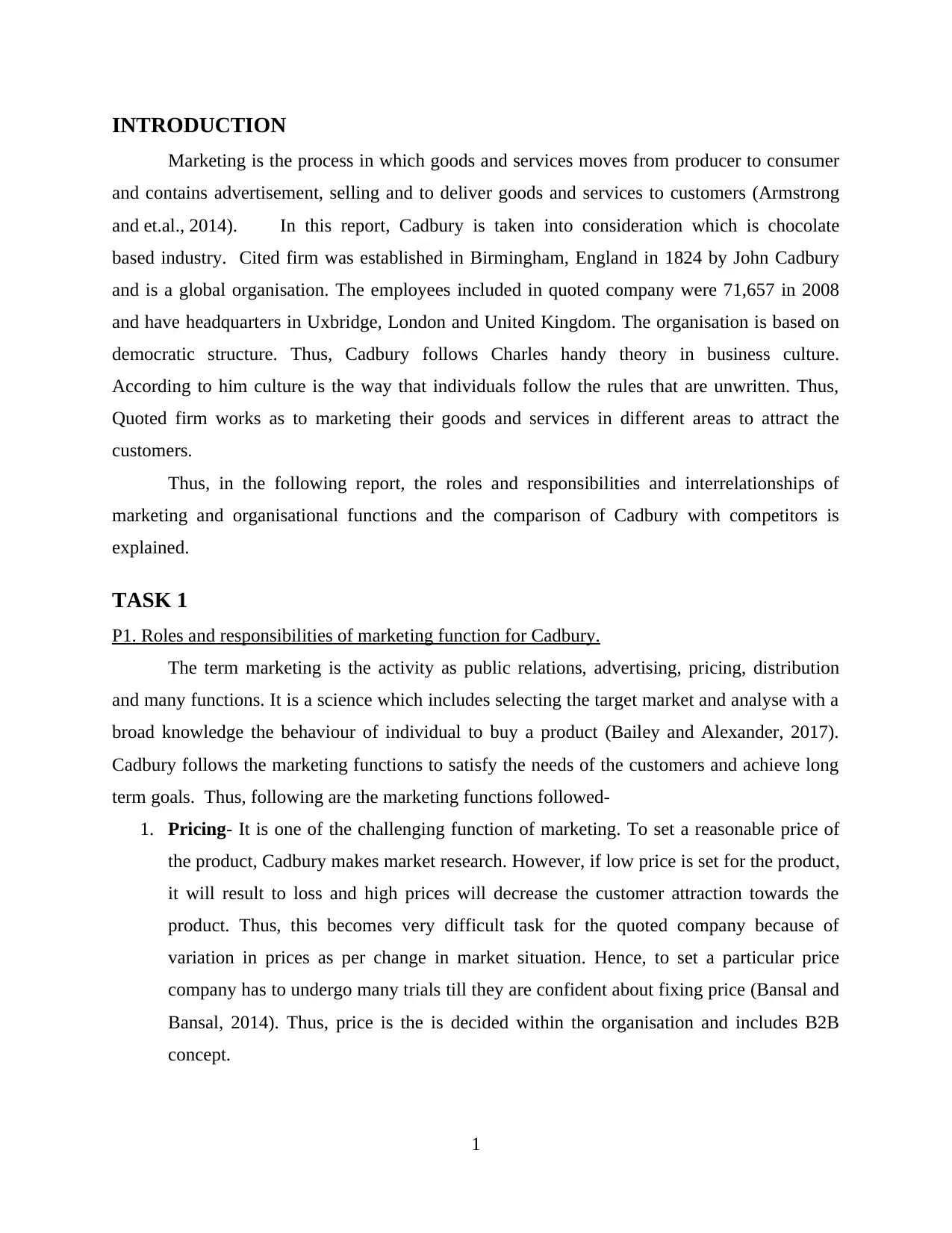
INTRODUCTION
Marketing is the process in which goods and services moves from producer to consumer
and contains advertisement, selling and to deliver goods and services to customers (Armstrong
and et.al., 2014). In this report, Cadbury is taken into consideration which is chocolate
based industry. Cited firm was established in Birmingham, England in 1824 by John Cadbury
and is a global organisation. The employees included in quoted company were 71,657 in 2008
and have headquarters in Uxbridge, London and United Kingdom. The organisation is based on
democratic structure. Thus, Cadbury follows Charles handy theory in business culture.
According to him culture is the way that individuals follow the rules that are unwritten. Thus,
Quoted firm works as to marketing their goods and services in different areas to attract the
customers.
Thus, in the following report, the roles and responsibilities and interrelationships of
marketing and organisational functions and the comparison of Cadbury with competitors is
explained.
TASK 1
P1. Roles and responsibilities of marketing function for Cadbury.
The term marketing is the activity as public relations, advertising, pricing, distribution
and many functions. It is a science which includes selecting the target market and analyse with a
broad knowledge the behaviour of individual to buy a product (Bailey and Alexander, 2017).
Cadbury follows the marketing functions to satisfy the needs of the customers and achieve long
term goals. Thus, following are the marketing functions followed-
1. Pricing- It is one of the challenging function of marketing. To set a reasonable price of
the product, Cadbury makes market research. However, if low price is set for the product,
it will result to loss and high prices will decrease the customer attraction towards the
product. Thus, this becomes very difficult task for the quoted company because of
variation in prices as per change in market situation. Hence, to set a particular price
company has to undergo many trials till they are confident about fixing price (Bansal and
Bansal, 2014). Thus, price is the is decided within the organisation and includes B2B
concept.
1
Marketing is the process in which goods and services moves from producer to consumer
and contains advertisement, selling and to deliver goods and services to customers (Armstrong
and et.al., 2014). In this report, Cadbury is taken into consideration which is chocolate
based industry. Cited firm was established in Birmingham, England in 1824 by John Cadbury
and is a global organisation. The employees included in quoted company were 71,657 in 2008
and have headquarters in Uxbridge, London and United Kingdom. The organisation is based on
democratic structure. Thus, Cadbury follows Charles handy theory in business culture.
According to him culture is the way that individuals follow the rules that are unwritten. Thus,
Quoted firm works as to marketing their goods and services in different areas to attract the
customers.
Thus, in the following report, the roles and responsibilities and interrelationships of
marketing and organisational functions and the comparison of Cadbury with competitors is
explained.
TASK 1
P1. Roles and responsibilities of marketing function for Cadbury.
The term marketing is the activity as public relations, advertising, pricing, distribution
and many functions. It is a science which includes selecting the target market and analyse with a
broad knowledge the behaviour of individual to buy a product (Bailey and Alexander, 2017).
Cadbury follows the marketing functions to satisfy the needs of the customers and achieve long
term goals. Thus, following are the marketing functions followed-
1. Pricing- It is one of the challenging function of marketing. To set a reasonable price of
the product, Cadbury makes market research. However, if low price is set for the product,
it will result to loss and high prices will decrease the customer attraction towards the
product. Thus, this becomes very difficult task for the quoted company because of
variation in prices as per change in market situation. Hence, to set a particular price
company has to undergo many trials till they are confident about fixing price (Bansal and
Bansal, 2014). Thus, price is the is decided within the organisation and includes B2B
concept.
1
⊘ This is a preview!⊘
Do you want full access?
Subscribe today to unlock all pages.

Trusted by 1+ million students worldwide
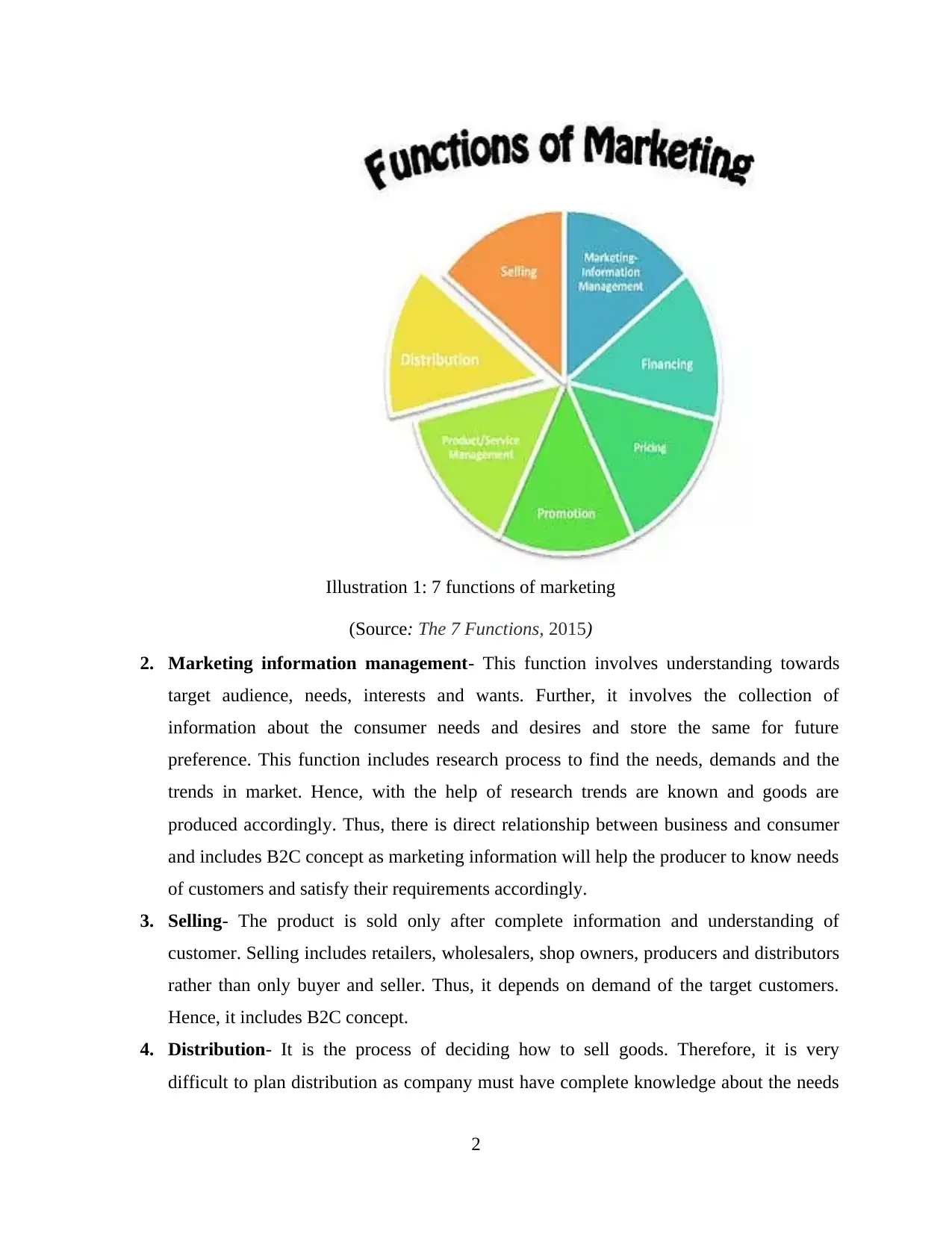
Illustration 1: 7 functions of marketing
(Source: The 7 Functions, 2015)
2. Marketing information management- This function involves understanding towards
target audience, needs, interests and wants. Further, it involves the collection of
information about the consumer needs and desires and store the same for future
preference. This function includes research process to find the needs, demands and the
trends in market. Hence, with the help of research trends are known and goods are
produced accordingly. Thus, there is direct relationship between business and consumer
and includes B2C concept as marketing information will help the producer to know needs
of customers and satisfy their requirements accordingly.
3. Selling- The product is sold only after complete information and understanding of
customer. Selling includes retailers, wholesalers, shop owners, producers and distributors
rather than only buyer and seller. Thus, it depends on demand of the target customers.
Hence, it includes B2C concept.
4. Distribution- It is the process of deciding how to sell goods. Therefore, it is very
difficult to plan distribution as company must have complete knowledge about the needs
2
(Source: The 7 Functions, 2015)
2. Marketing information management- This function involves understanding towards
target audience, needs, interests and wants. Further, it involves the collection of
information about the consumer needs and desires and store the same for future
preference. This function includes research process to find the needs, demands and the
trends in market. Hence, with the help of research trends are known and goods are
produced accordingly. Thus, there is direct relationship between business and consumer
and includes B2C concept as marketing information will help the producer to know needs
of customers and satisfy their requirements accordingly.
3. Selling- The product is sold only after complete information and understanding of
customer. Selling includes retailers, wholesalers, shop owners, producers and distributors
rather than only buyer and seller. Thus, it depends on demand of the target customers.
Hence, it includes B2C concept.
4. Distribution- It is the process of deciding how to sell goods. Therefore, it is very
difficult to plan distribution as company must have complete knowledge about the needs
2
Paraphrase This Document
Need a fresh take? Get an instant paraphrase of this document with our AI Paraphraser
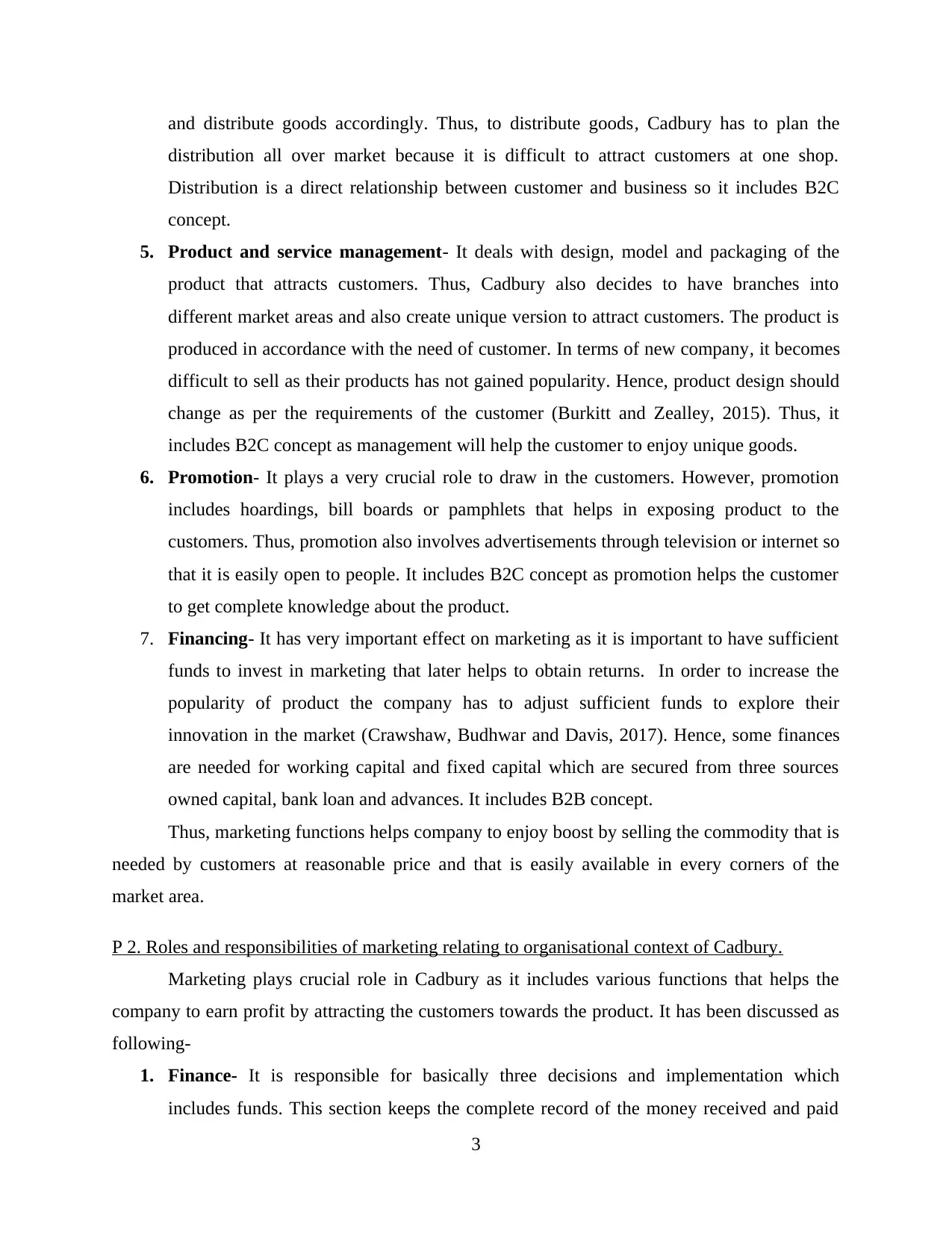
and distribute goods accordingly. Thus, to distribute goods, Cadbury has to plan the
distribution all over market because it is difficult to attract customers at one shop.
Distribution is a direct relationship between customer and business so it includes B2C
concept.
5. Product and service management- It deals with design, model and packaging of the
product that attracts customers. Thus, Cadbury also decides to have branches into
different market areas and also create unique version to attract customers. The product is
produced in accordance with the need of customer. In terms of new company, it becomes
difficult to sell as their products has not gained popularity. Hence, product design should
change as per the requirements of the customer (Burkitt and Zealley, 2015). Thus, it
includes B2C concept as management will help the customer to enjoy unique goods.
6. Promotion- It plays a very crucial role to draw in the customers. However, promotion
includes hoardings, bill boards or pamphlets that helps in exposing product to the
customers. Thus, promotion also involves advertisements through television or internet so
that it is easily open to people. It includes B2C concept as promotion helps the customer
to get complete knowledge about the product.
7. Financing- It has very important effect on marketing as it is important to have sufficient
funds to invest in marketing that later helps to obtain returns. In order to increase the
popularity of product the company has to adjust sufficient funds to explore their
innovation in the market (Crawshaw, Budhwar and Davis, 2017). Hence, some finances
are needed for working capital and fixed capital which are secured from three sources
owned capital, bank loan and advances. It includes B2B concept.
Thus, marketing functions helps company to enjoy boost by selling the commodity that is
needed by customers at reasonable price and that is easily available in every corners of the
market area.
P 2. Roles and responsibilities of marketing relating to organisational context of Cadbury.
Marketing plays crucial role in Cadbury as it includes various functions that helps the
company to earn profit by attracting the customers towards the product. It has been discussed as
following-
1. Finance- It is responsible for basically three decisions and implementation which
includes funds. This section keeps the complete record of the money received and paid
3
distribution all over market because it is difficult to attract customers at one shop.
Distribution is a direct relationship between customer and business so it includes B2C
concept.
5. Product and service management- It deals with design, model and packaging of the
product that attracts customers. Thus, Cadbury also decides to have branches into
different market areas and also create unique version to attract customers. The product is
produced in accordance with the need of customer. In terms of new company, it becomes
difficult to sell as their products has not gained popularity. Hence, product design should
change as per the requirements of the customer (Burkitt and Zealley, 2015). Thus, it
includes B2C concept as management will help the customer to enjoy unique goods.
6. Promotion- It plays a very crucial role to draw in the customers. However, promotion
includes hoardings, bill boards or pamphlets that helps in exposing product to the
customers. Thus, promotion also involves advertisements through television or internet so
that it is easily open to people. It includes B2C concept as promotion helps the customer
to get complete knowledge about the product.
7. Financing- It has very important effect on marketing as it is important to have sufficient
funds to invest in marketing that later helps to obtain returns. In order to increase the
popularity of product the company has to adjust sufficient funds to explore their
innovation in the market (Crawshaw, Budhwar and Davis, 2017). Hence, some finances
are needed for working capital and fixed capital which are secured from three sources
owned capital, bank loan and advances. It includes B2B concept.
Thus, marketing functions helps company to enjoy boost by selling the commodity that is
needed by customers at reasonable price and that is easily available in every corners of the
market area.
P 2. Roles and responsibilities of marketing relating to organisational context of Cadbury.
Marketing plays crucial role in Cadbury as it includes various functions that helps the
company to earn profit by attracting the customers towards the product. It has been discussed as
following-
1. Finance- It is responsible for basically three decisions and implementation which
includes funds. This section keeps the complete record of the money received and paid
3
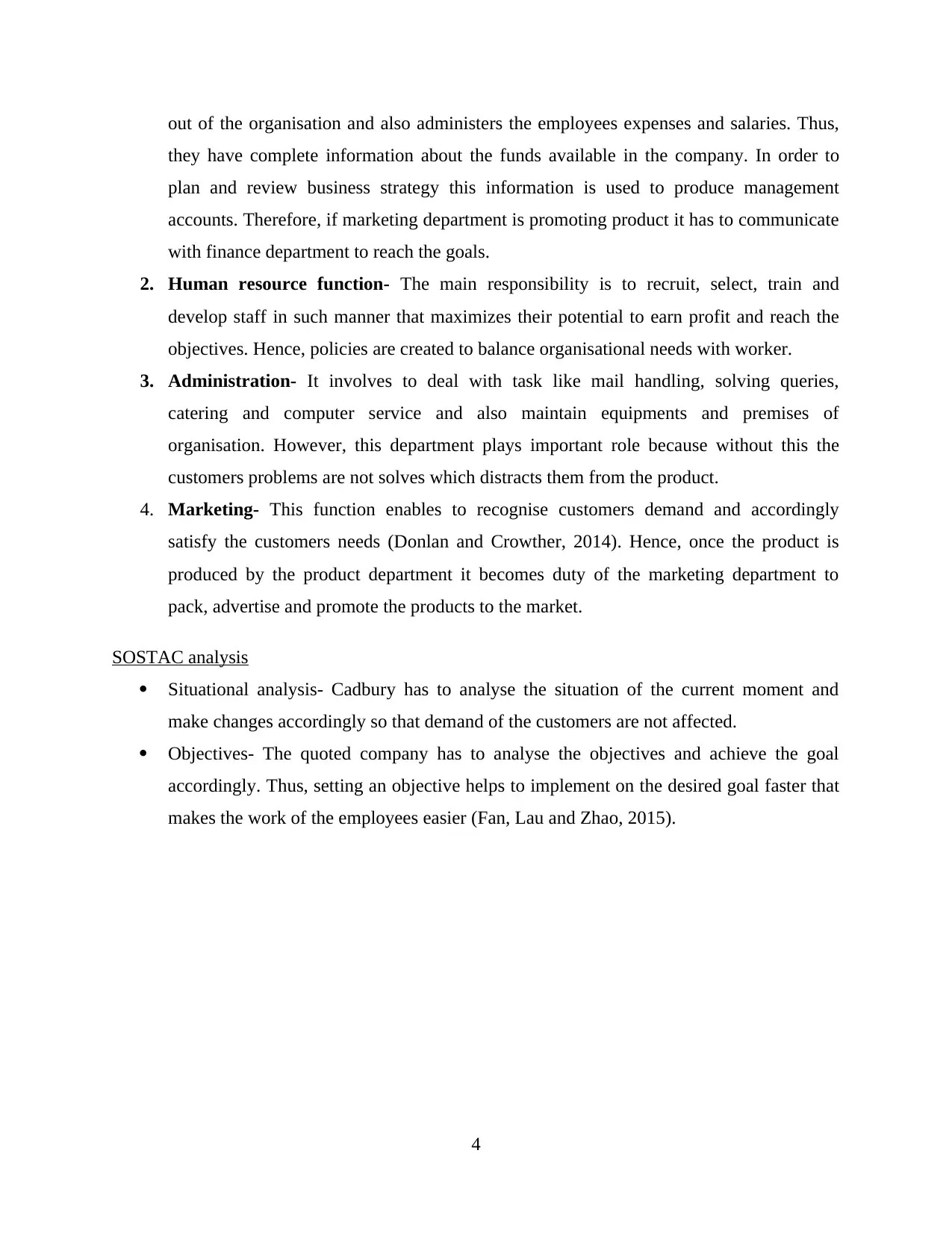
out of the organisation and also administers the employees expenses and salaries. Thus,
they have complete information about the funds available in the company. In order to
plan and review business strategy this information is used to produce management
accounts. Therefore, if marketing department is promoting product it has to communicate
with finance department to reach the goals.
2. Human resource function- The main responsibility is to recruit, select, train and
develop staff in such manner that maximizes their potential to earn profit and reach the
objectives. Hence, policies are created to balance organisational needs with worker.
3. Administration- It involves to deal with task like mail handling, solving queries,
catering and computer service and also maintain equipments and premises of
organisation. However, this department plays important role because without this the
customers problems are not solves which distracts them from the product.
4. Marketing- This function enables to recognise customers demand and accordingly
satisfy the customers needs (Donlan and Crowther, 2014). Hence, once the product is
produced by the product department it becomes duty of the marketing department to
pack, advertise and promote the products to the market.
SOSTAC analysis
Situational analysis- Cadbury has to analyse the situation of the current moment and
make changes accordingly so that demand of the customers are not affected.
Objectives- The quoted company has to analyse the objectives and achieve the goal
accordingly. Thus, setting an objective helps to implement on the desired goal faster that
makes the work of the employees easier (Fan, Lau and Zhao, 2015).
4
they have complete information about the funds available in the company. In order to
plan and review business strategy this information is used to produce management
accounts. Therefore, if marketing department is promoting product it has to communicate
with finance department to reach the goals.
2. Human resource function- The main responsibility is to recruit, select, train and
develop staff in such manner that maximizes their potential to earn profit and reach the
objectives. Hence, policies are created to balance organisational needs with worker.
3. Administration- It involves to deal with task like mail handling, solving queries,
catering and computer service and also maintain equipments and premises of
organisation. However, this department plays important role because without this the
customers problems are not solves which distracts them from the product.
4. Marketing- This function enables to recognise customers demand and accordingly
satisfy the customers needs (Donlan and Crowther, 2014). Hence, once the product is
produced by the product department it becomes duty of the marketing department to
pack, advertise and promote the products to the market.
SOSTAC analysis
Situational analysis- Cadbury has to analyse the situation of the current moment and
make changes accordingly so that demand of the customers are not affected.
Objectives- The quoted company has to analyse the objectives and achieve the goal
accordingly. Thus, setting an objective helps to implement on the desired goal faster that
makes the work of the employees easier (Fan, Lau and Zhao, 2015).
4
⊘ This is a preview!⊘
Do you want full access?
Subscribe today to unlock all pages.

Trusted by 1+ million students worldwide
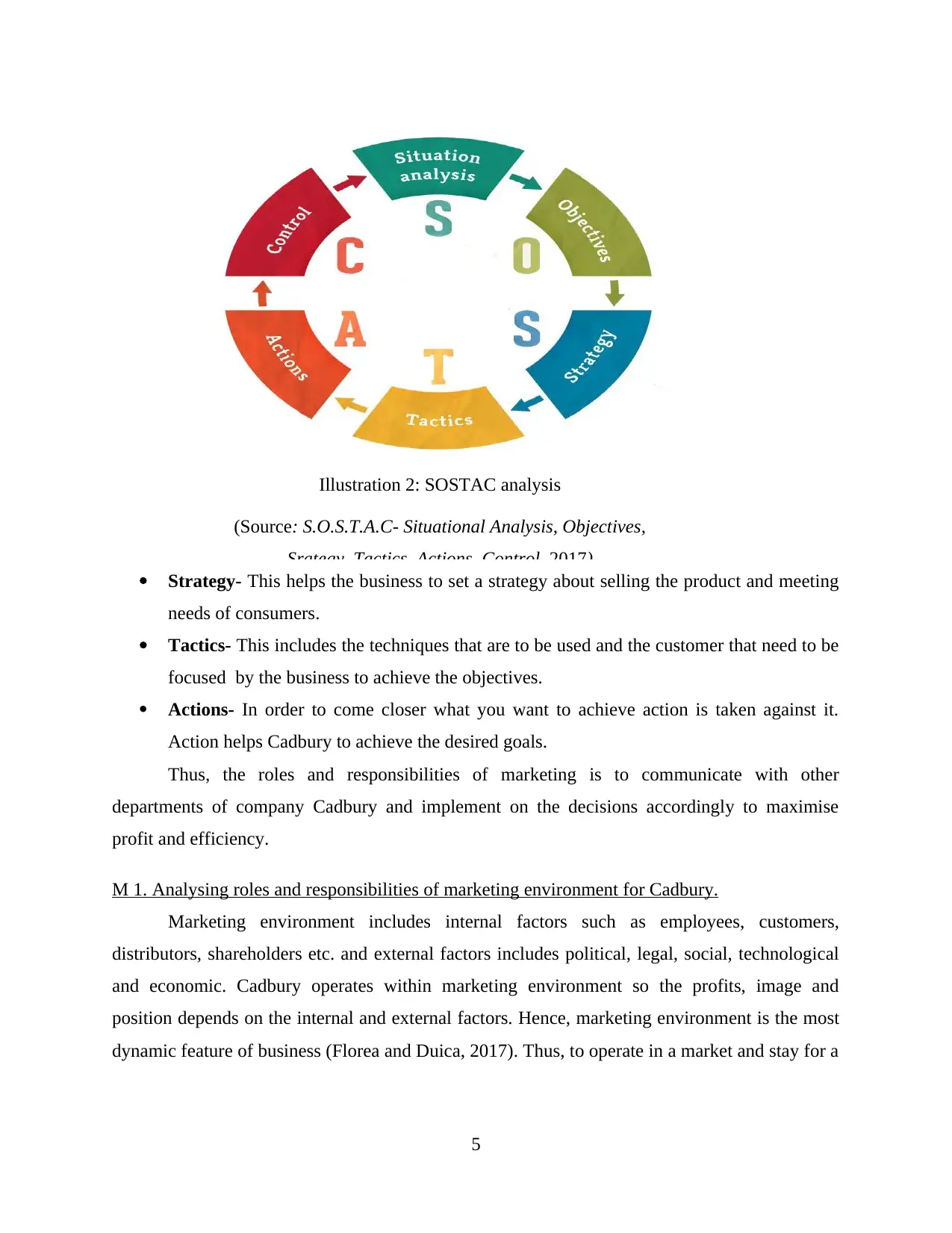
Illustration 2: SOSTAC analysis
(Source: S.O.S.T.A.C- Situational Analysis, Objectives,
Srategy, Tactics, Actions, Control, 2017)
Strategy- This helps the business to set a strategy about selling the product and meeting
needs of consumers.
Tactics- This includes the techniques that are to be used and the customer that need to be
focused by the business to achieve the objectives.
Actions- In order to come closer what you want to achieve action is taken against it.
Action helps Cadbury to achieve the desired goals.
Thus, the roles and responsibilities of marketing is to communicate with other
departments of company Cadbury and implement on the decisions accordingly to maximise
profit and efficiency.
M 1. Analysing roles and responsibilities of marketing environment for Cadbury.
Marketing environment includes internal factors such as employees, customers,
distributors, shareholders etc. and external factors includes political, legal, social, technological
and economic. Cadbury operates within marketing environment so the profits, image and
position depends on the internal and external factors. Hence, marketing environment is the most
dynamic feature of business (Florea and Duica, 2017). Thus, to operate in a market and stay for a
5
(Source: S.O.S.T.A.C- Situational Analysis, Objectives,
Srategy, Tactics, Actions, Control, 2017)
Strategy- This helps the business to set a strategy about selling the product and meeting
needs of consumers.
Tactics- This includes the techniques that are to be used and the customer that need to be
focused by the business to achieve the objectives.
Actions- In order to come closer what you want to achieve action is taken against it.
Action helps Cadbury to achieve the desired goals.
Thus, the roles and responsibilities of marketing is to communicate with other
departments of company Cadbury and implement on the decisions accordingly to maximise
profit and efficiency.
M 1. Analysing roles and responsibilities of marketing environment for Cadbury.
Marketing environment includes internal factors such as employees, customers,
distributors, shareholders etc. and external factors includes political, legal, social, technological
and economic. Cadbury operates within marketing environment so the profits, image and
position depends on the internal and external factors. Hence, marketing environment is the most
dynamic feature of business (Florea and Duica, 2017). Thus, to operate in a market and stay for a
5
Paraphrase This Document
Need a fresh take? Get an instant paraphrase of this document with our AI Paraphraser
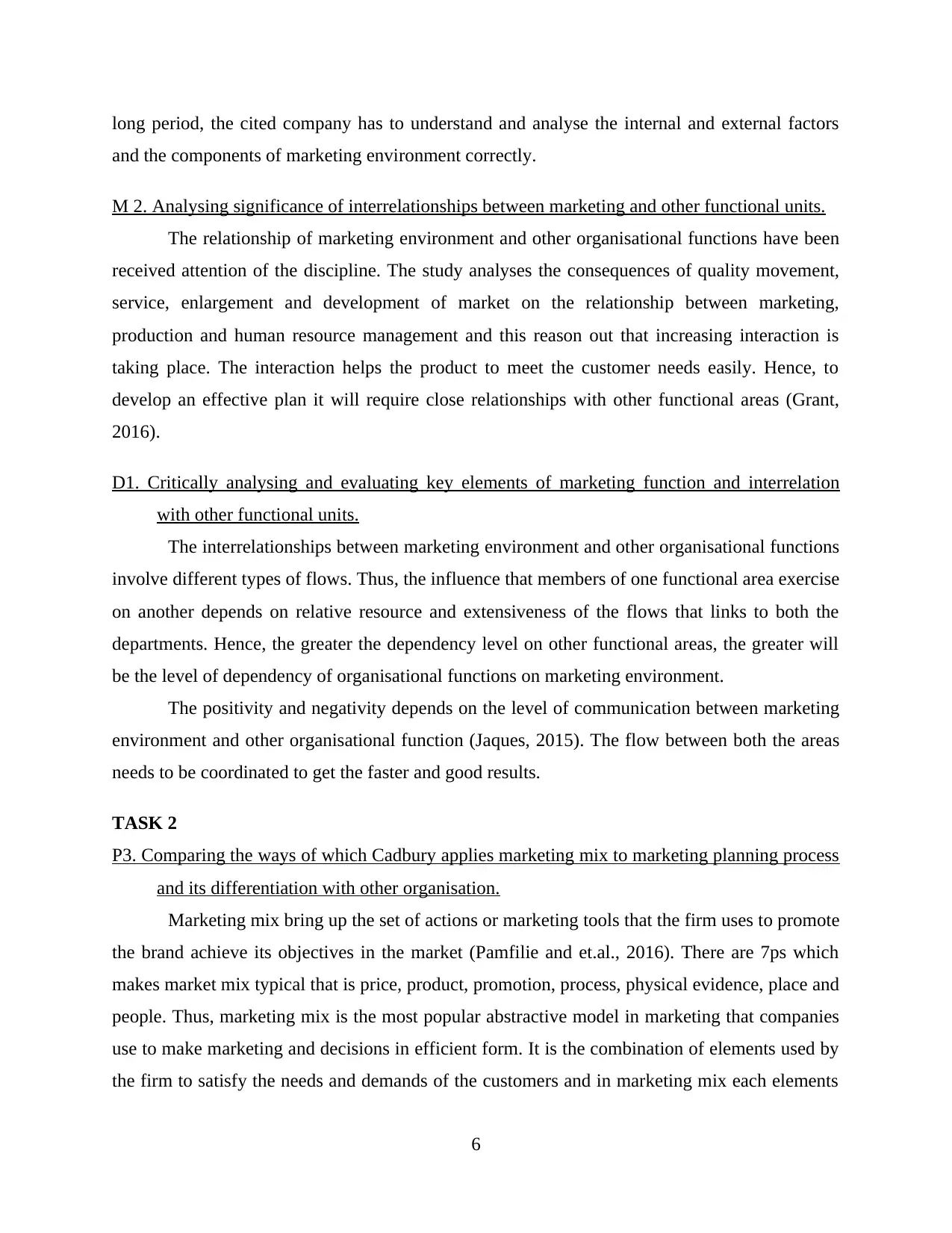
long period, the cited company has to understand and analyse the internal and external factors
and the components of marketing environment correctly.
M 2. Analysing significance of interrelationships between marketing and other functional units.
The relationship of marketing environment and other organisational functions have been
received attention of the discipline. The study analyses the consequences of quality movement,
service, enlargement and development of market on the relationship between marketing,
production and human resource management and this reason out that increasing interaction is
taking place. The interaction helps the product to meet the customer needs easily. Hence, to
develop an effective plan it will require close relationships with other functional areas (Grant,
2016).
D1. Critically analysing and evaluating key elements of marketing function and interrelation
with other functional units.
The interrelationships between marketing environment and other organisational functions
involve different types of flows. Thus, the influence that members of one functional area exercise
on another depends on relative resource and extensiveness of the flows that links to both the
departments. Hence, the greater the dependency level on other functional areas, the greater will
be the level of dependency of organisational functions on marketing environment.
The positivity and negativity depends on the level of communication between marketing
environment and other organisational function (Jaques, 2015). The flow between both the areas
needs to be coordinated to get the faster and good results.
TASK 2
P3. Comparing the ways of which Cadbury applies marketing mix to marketing planning process
and its differentiation with other organisation.
Marketing mix bring up the set of actions or marketing tools that the firm uses to promote
the brand achieve its objectives in the market (Pamfilie and et.al., 2016). There are 7ps which
makes market mix typical that is price, product, promotion, process, physical evidence, place and
people. Thus, marketing mix is the most popular abstractive model in marketing that companies
use to make marketing and decisions in efficient form. It is the combination of elements used by
the firm to satisfy the needs and demands of the customers and in marketing mix each elements
6
and the components of marketing environment correctly.
M 2. Analysing significance of interrelationships between marketing and other functional units.
The relationship of marketing environment and other organisational functions have been
received attention of the discipline. The study analyses the consequences of quality movement,
service, enlargement and development of market on the relationship between marketing,
production and human resource management and this reason out that increasing interaction is
taking place. The interaction helps the product to meet the customer needs easily. Hence, to
develop an effective plan it will require close relationships with other functional areas (Grant,
2016).
D1. Critically analysing and evaluating key elements of marketing function and interrelation
with other functional units.
The interrelationships between marketing environment and other organisational functions
involve different types of flows. Thus, the influence that members of one functional area exercise
on another depends on relative resource and extensiveness of the flows that links to both the
departments. Hence, the greater the dependency level on other functional areas, the greater will
be the level of dependency of organisational functions on marketing environment.
The positivity and negativity depends on the level of communication between marketing
environment and other organisational function (Jaques, 2015). The flow between both the areas
needs to be coordinated to get the faster and good results.
TASK 2
P3. Comparing the ways of which Cadbury applies marketing mix to marketing planning process
and its differentiation with other organisation.
Marketing mix bring up the set of actions or marketing tools that the firm uses to promote
the brand achieve its objectives in the market (Pamfilie and et.al., 2016). There are 7ps which
makes market mix typical that is price, product, promotion, process, physical evidence, place and
people. Thus, marketing mix is the most popular abstractive model in marketing that companies
use to make marketing and decisions in efficient form. It is the combination of elements used by
the firm to satisfy the needs and demands of the customers and in marketing mix each elements
6
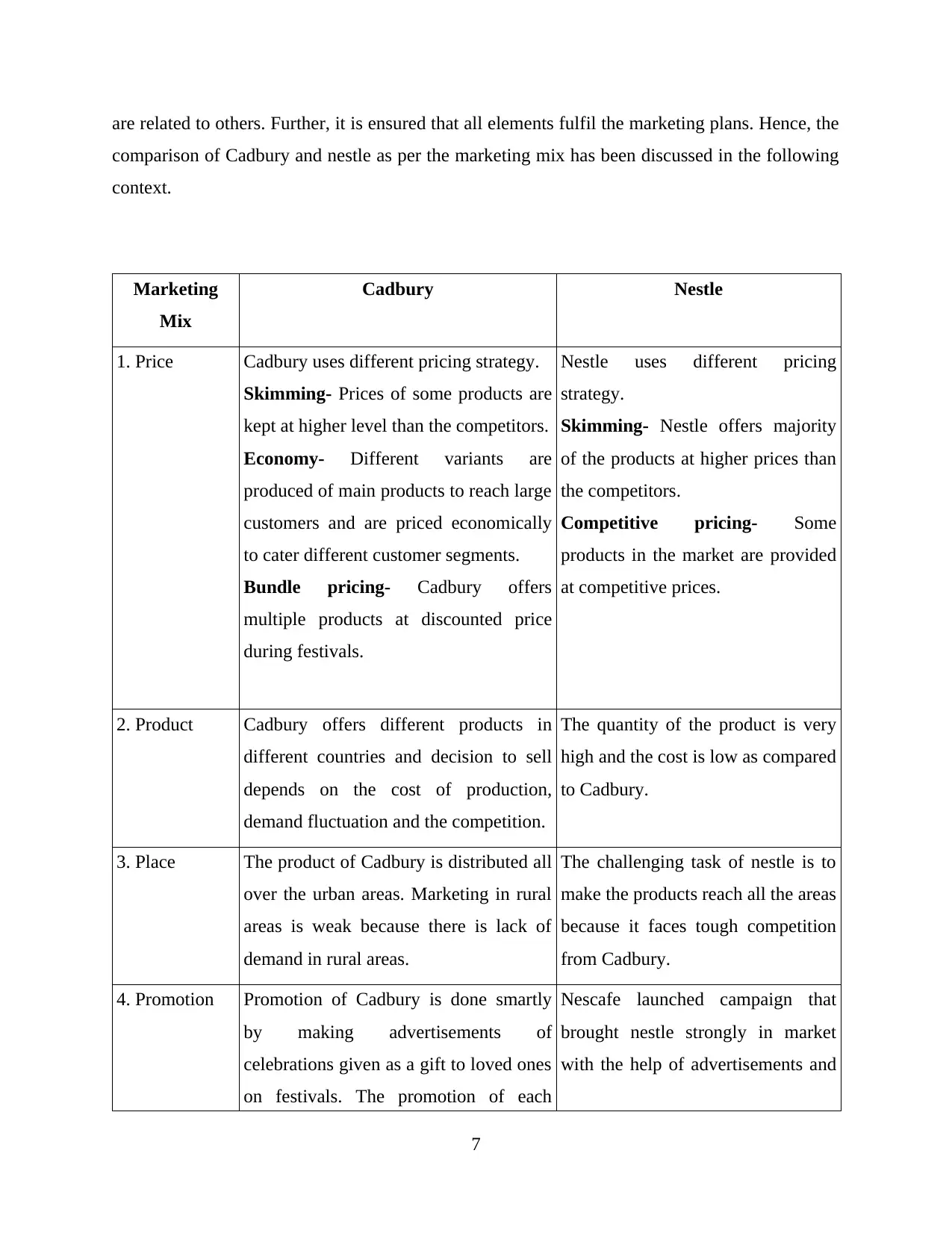
are related to others. Further, it is ensured that all elements fulfil the marketing plans. Hence, the
comparison of Cadbury and nestle as per the marketing mix has been discussed in the following
context.
Marketing
Mix
Cadbury Nestle
1. Price Cadbury uses different pricing strategy.
Skimming- Prices of some products are
kept at higher level than the competitors.
Economy- Different variants are
produced of main products to reach large
customers and are priced economically
to cater different customer segments.
Bundle pricing- Cadbury offers
multiple products at discounted price
during festivals.
Nestle uses different pricing
strategy.
Skimming- Nestle offers majority
of the products at higher prices than
the competitors.
Competitive pricing- Some
products in the market are provided
at competitive prices.
2. Product Cadbury offers different products in
different countries and decision to sell
depends on the cost of production,
demand fluctuation and the competition.
The quantity of the product is very
high and the cost is low as compared
to Cadbury.
3. Place The product of Cadbury is distributed all
over the urban areas. Marketing in rural
areas is weak because there is lack of
demand in rural areas.
The challenging task of nestle is to
make the products reach all the areas
because it faces tough competition
from Cadbury.
4. Promotion Promotion of Cadbury is done smartly
by making advertisements of
celebrations given as a gift to loved ones
on festivals. The promotion of each
Nescafe launched campaign that
brought nestle strongly in market
with the help of advertisements and
7
comparison of Cadbury and nestle as per the marketing mix has been discussed in the following
context.
Marketing
Mix
Cadbury Nestle
1. Price Cadbury uses different pricing strategy.
Skimming- Prices of some products are
kept at higher level than the competitors.
Economy- Different variants are
produced of main products to reach large
customers and are priced economically
to cater different customer segments.
Bundle pricing- Cadbury offers
multiple products at discounted price
during festivals.
Nestle uses different pricing
strategy.
Skimming- Nestle offers majority
of the products at higher prices than
the competitors.
Competitive pricing- Some
products in the market are provided
at competitive prices.
2. Product Cadbury offers different products in
different countries and decision to sell
depends on the cost of production,
demand fluctuation and the competition.
The quantity of the product is very
high and the cost is low as compared
to Cadbury.
3. Place The product of Cadbury is distributed all
over the urban areas. Marketing in rural
areas is weak because there is lack of
demand in rural areas.
The challenging task of nestle is to
make the products reach all the areas
because it faces tough competition
from Cadbury.
4. Promotion Promotion of Cadbury is done smartly
by making advertisements of
celebrations given as a gift to loved ones
on festivals. The promotion of each
Nescafe launched campaign that
brought nestle strongly in market
with the help of advertisements and
7
⊘ This is a preview!⊘
Do you want full access?
Subscribe today to unlock all pages.

Trusted by 1+ million students worldwide
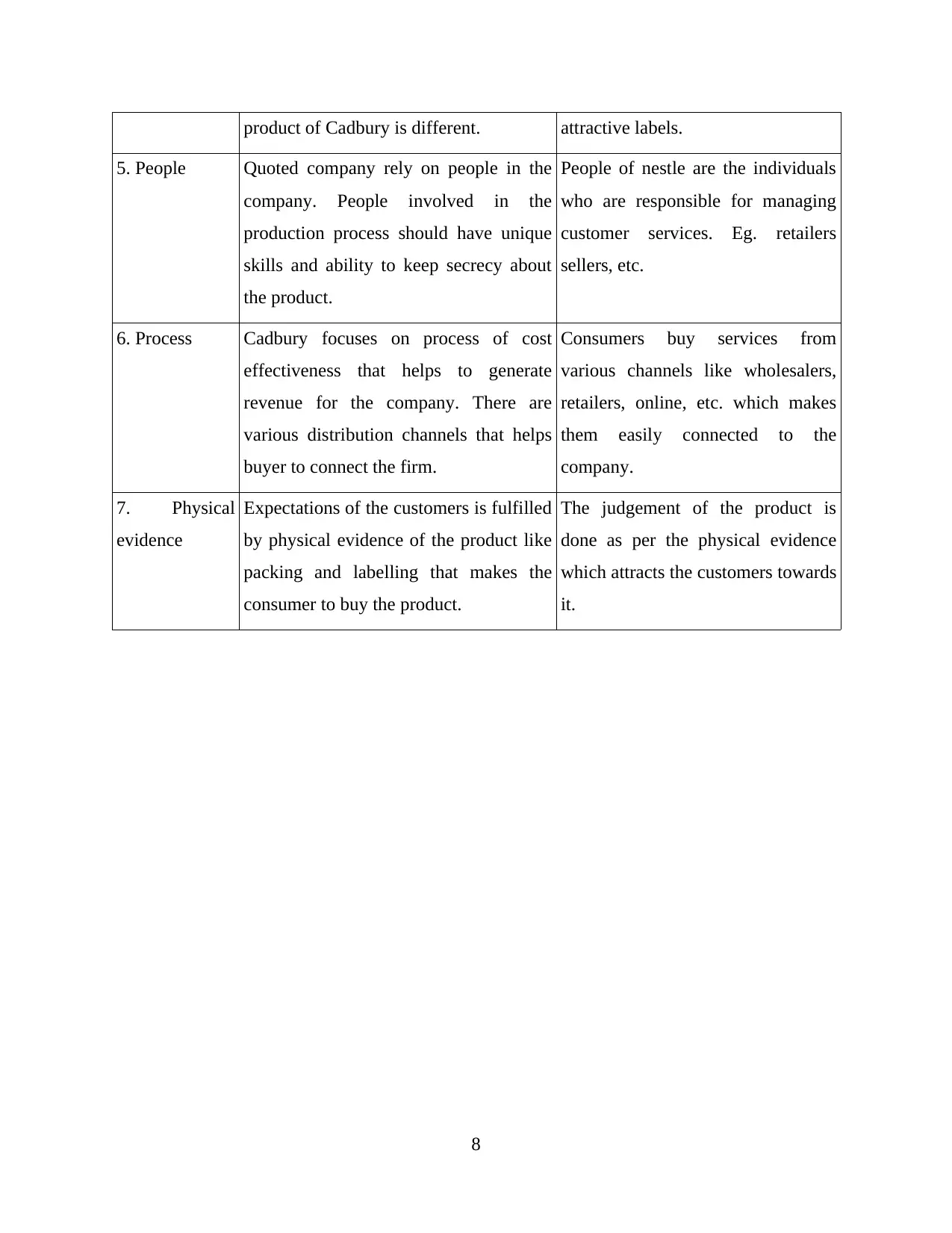
product of Cadbury is different. attractive labels.
5. People Quoted company rely on people in the
company. People involved in the
production process should have unique
skills and ability to keep secrecy about
the product.
People of nestle are the individuals
who are responsible for managing
customer services. Eg. retailers
sellers, etc.
6. Process Cadbury focuses on process of cost
effectiveness that helps to generate
revenue for the company. There are
various distribution channels that helps
buyer to connect the firm.
Consumers buy services from
various channels like wholesalers,
retailers, online, etc. which makes
them easily connected to the
company.
7. Physical
evidence
Expectations of the customers is fulfilled
by physical evidence of the product like
packing and labelling that makes the
consumer to buy the product.
The judgement of the product is
done as per the physical evidence
which attracts the customers towards
it.
8
5. People Quoted company rely on people in the
company. People involved in the
production process should have unique
skills and ability to keep secrecy about
the product.
People of nestle are the individuals
who are responsible for managing
customer services. Eg. retailers
sellers, etc.
6. Process Cadbury focuses on process of cost
effectiveness that helps to generate
revenue for the company. There are
various distribution channels that helps
buyer to connect the firm.
Consumers buy services from
various channels like wholesalers,
retailers, online, etc. which makes
them easily connected to the
company.
7. Physical
evidence
Expectations of the customers is fulfilled
by physical evidence of the product like
packing and labelling that makes the
consumer to buy the product.
The judgement of the product is
done as per the physical evidence
which attracts the customers towards
it.
8
Paraphrase This Document
Need a fresh take? Get an instant paraphrase of this document with our AI Paraphraser
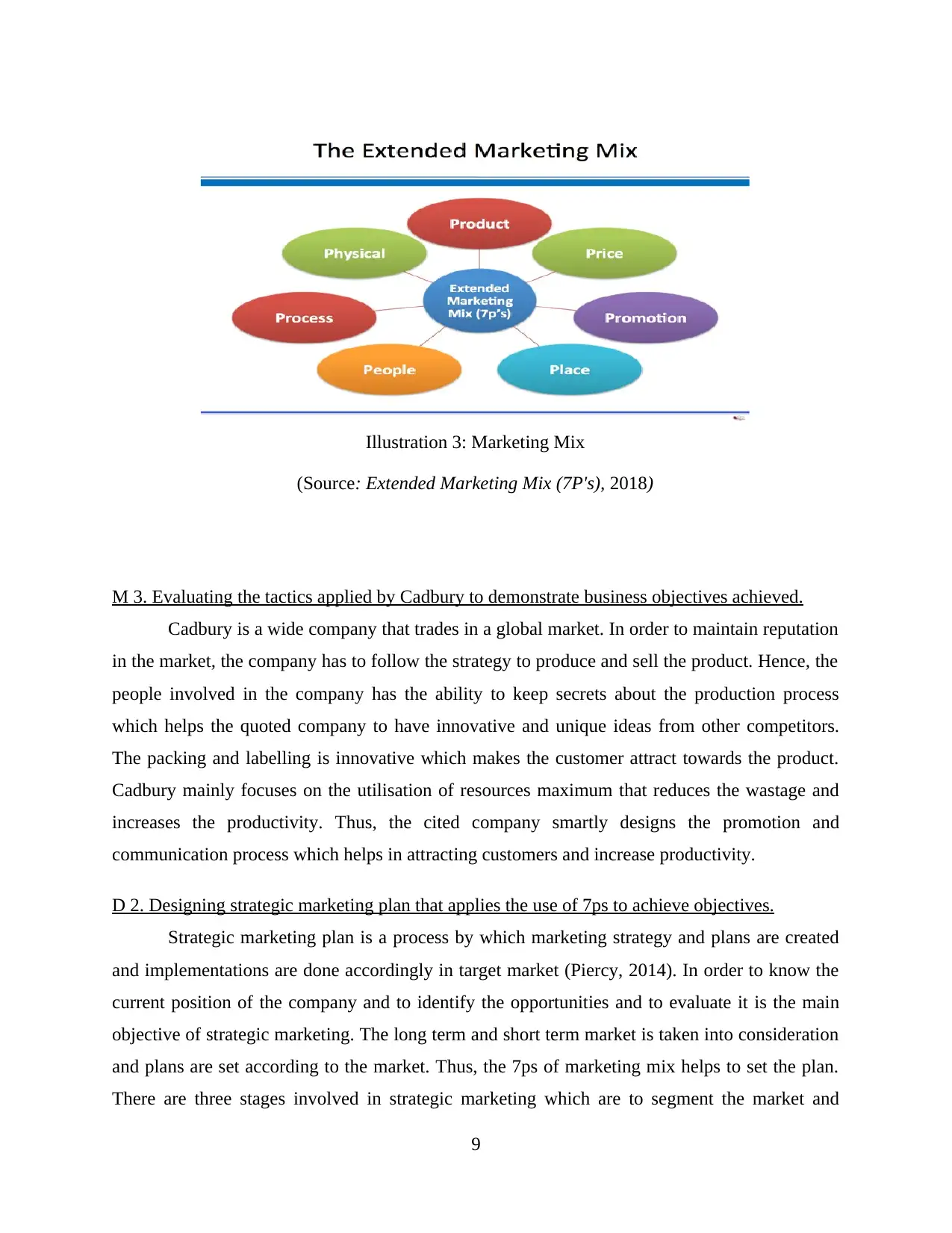
Illustration 3: Marketing Mix
(Source: Extended Marketing Mix (7P's), 2018)
M 3. Evaluating the tactics applied by Cadbury to demonstrate business objectives achieved.
Cadbury is a wide company that trades in a global market. In order to maintain reputation
in the market, the company has to follow the strategy to produce and sell the product. Hence, the
people involved in the company has the ability to keep secrets about the production process
which helps the quoted company to have innovative and unique ideas from other competitors.
The packing and labelling is innovative which makes the customer attract towards the product.
Cadbury mainly focuses on the utilisation of resources maximum that reduces the wastage and
increases the productivity. Thus, the cited company smartly designs the promotion and
communication process which helps in attracting customers and increase productivity.
D 2. Designing strategic marketing plan that applies the use of 7ps to achieve objectives.
Strategic marketing plan is a process by which marketing strategy and plans are created
and implementations are done accordingly in target market (Piercy, 2014). In order to know the
current position of the company and to identify the opportunities and to evaluate it is the main
objective of strategic marketing. The long term and short term market is taken into consideration
and plans are set according to the market. Thus, the 7ps of marketing mix helps to set the plan.
There are three stages involved in strategic marketing which are to segment the market and
9
(Source: Extended Marketing Mix (7P's), 2018)
M 3. Evaluating the tactics applied by Cadbury to demonstrate business objectives achieved.
Cadbury is a wide company that trades in a global market. In order to maintain reputation
in the market, the company has to follow the strategy to produce and sell the product. Hence, the
people involved in the company has the ability to keep secrets about the production process
which helps the quoted company to have innovative and unique ideas from other competitors.
The packing and labelling is innovative which makes the customer attract towards the product.
Cadbury mainly focuses on the utilisation of resources maximum that reduces the wastage and
increases the productivity. Thus, the cited company smartly designs the promotion and
communication process which helps in attracting customers and increase productivity.
D 2. Designing strategic marketing plan that applies the use of 7ps to achieve objectives.
Strategic marketing plan is a process by which marketing strategy and plans are created
and implementations are done accordingly in target market (Piercy, 2014). In order to know the
current position of the company and to identify the opportunities and to evaluate it is the main
objective of strategic marketing. The long term and short term market is taken into consideration
and plans are set according to the market. Thus, the 7ps of marketing mix helps to set the plan.
There are three stages involved in strategic marketing which are to segment the market and
9
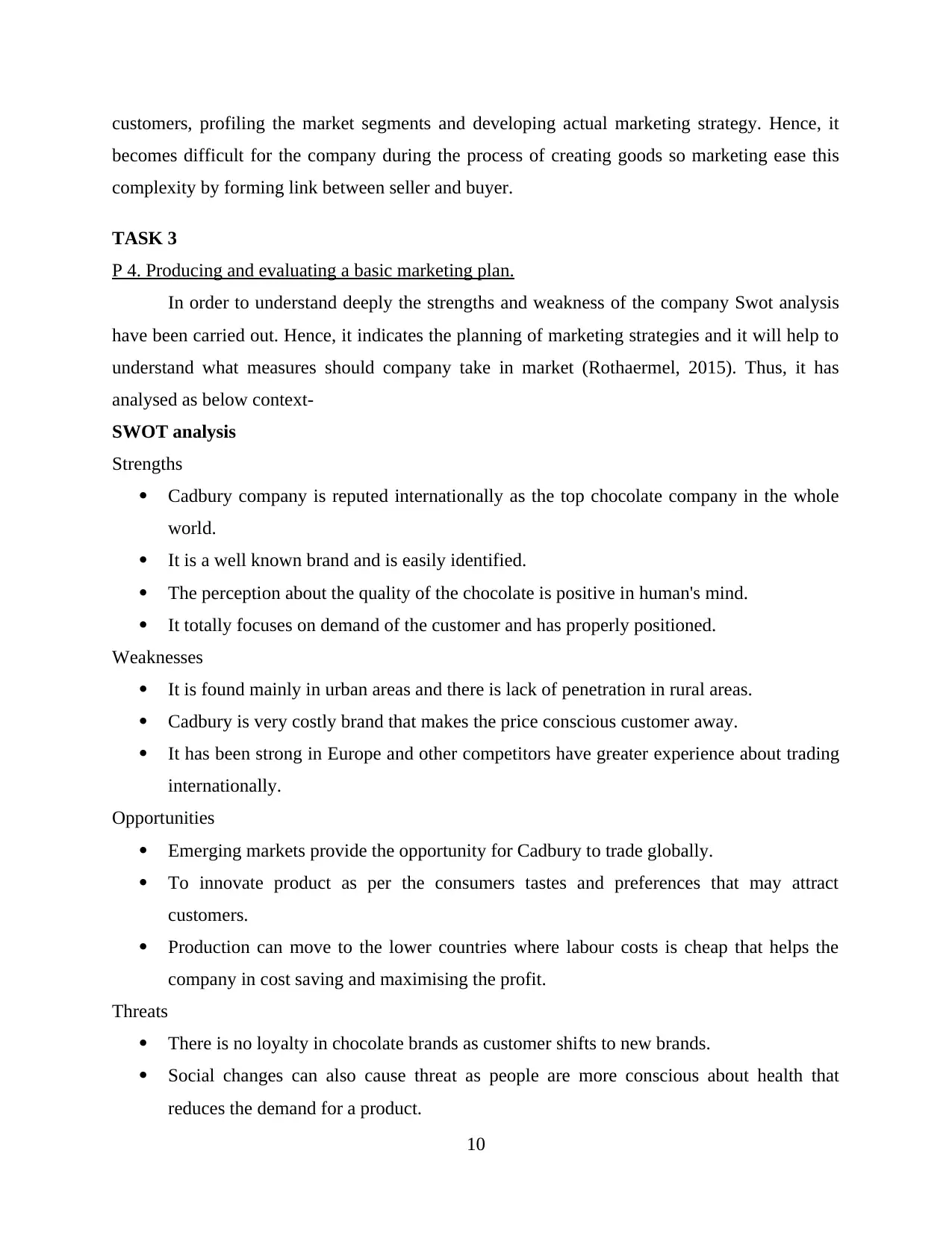
customers, profiling the market segments and developing actual marketing strategy. Hence, it
becomes difficult for the company during the process of creating goods so marketing ease this
complexity by forming link between seller and buyer.
TASK 3
P 4. Producing and evaluating a basic marketing plan.
In order to understand deeply the strengths and weakness of the company Swot analysis
have been carried out. Hence, it indicates the planning of marketing strategies and it will help to
understand what measures should company take in market (Rothaermel, 2015). Thus, it has
analysed as below context-
SWOT analysis
Strengths
Cadbury company is reputed internationally as the top chocolate company in the whole
world.
It is a well known brand and is easily identified.
The perception about the quality of the chocolate is positive in human's mind.
It totally focuses on demand of the customer and has properly positioned.
Weaknesses
It is found mainly in urban areas and there is lack of penetration in rural areas.
Cadbury is very costly brand that makes the price conscious customer away.
It has been strong in Europe and other competitors have greater experience about trading
internationally.
Opportunities
Emerging markets provide the opportunity for Cadbury to trade globally.
To innovate product as per the consumers tastes and preferences that may attract
customers.
Production can move to the lower countries where labour costs is cheap that helps the
company in cost saving and maximising the profit.
Threats
There is no loyalty in chocolate brands as customer shifts to new brands.
Social changes can also cause threat as people are more conscious about health that
reduces the demand for a product.
10
becomes difficult for the company during the process of creating goods so marketing ease this
complexity by forming link between seller and buyer.
TASK 3
P 4. Producing and evaluating a basic marketing plan.
In order to understand deeply the strengths and weakness of the company Swot analysis
have been carried out. Hence, it indicates the planning of marketing strategies and it will help to
understand what measures should company take in market (Rothaermel, 2015). Thus, it has
analysed as below context-
SWOT analysis
Strengths
Cadbury company is reputed internationally as the top chocolate company in the whole
world.
It is a well known brand and is easily identified.
The perception about the quality of the chocolate is positive in human's mind.
It totally focuses on demand of the customer and has properly positioned.
Weaknesses
It is found mainly in urban areas and there is lack of penetration in rural areas.
Cadbury is very costly brand that makes the price conscious customer away.
It has been strong in Europe and other competitors have greater experience about trading
internationally.
Opportunities
Emerging markets provide the opportunity for Cadbury to trade globally.
To innovate product as per the consumers tastes and preferences that may attract
customers.
Production can move to the lower countries where labour costs is cheap that helps the
company in cost saving and maximising the profit.
Threats
There is no loyalty in chocolate brands as customer shifts to new brands.
Social changes can also cause threat as people are more conscious about health that
reduces the demand for a product.
10
⊘ This is a preview!⊘
Do you want full access?
Subscribe today to unlock all pages.

Trusted by 1+ million students worldwide
1 out of 19
Related Documents
Your All-in-One AI-Powered Toolkit for Academic Success.
+13062052269
info@desklib.com
Available 24*7 on WhatsApp / Email
![[object Object]](/_next/static/media/star-bottom.7253800d.svg)
Unlock your academic potential
Copyright © 2020–2025 A2Z Services. All Rights Reserved. Developed and managed by ZUCOL.




